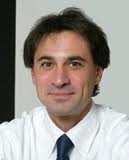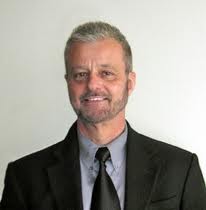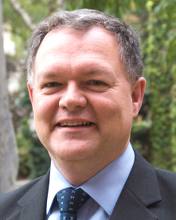Keynote talks
Keynote talks will be presented in plenary sessions. The confirmed plenary speakers include (in alphabetical order):
- * Richard D. Braatz, Process Systems Engineering Laboratory, MIT, USA
- * Dario Floreano, Laboratory of Intelligent Systems, EPFL, Switzerland
- * Frank Lewis, ARRI, The University of Texas at Arlington, USA
- * Iven Mareels, Biomedical Engineering, The University of Melbourne, Australia.
KEYNOTE/PLENARY SPEAKERS AND TALKS
Control of Molecular Purity, Crystal Structure, and Particle Size Distribution in Pharmaceutical Crystallization
Richard D. Braatz
Process Systems Engineering Laboratory, MIT, USA
 Richard D. Braatz is the Gilliland Professor at the Massachusetts Institute of
Technology (MIT) where he does research in control theory and its application
to biomedical systems, pharmaceuticals manufacturing, and nanotechnology. He
received MS and PhD degrees from the California Institute of Technology
and was a Professor at the University of Illinois at Urbana-Champaign and a Visiting
Scholar at Harvard University before moving to MIT. He has consulted or
collaborated with numerous companies including IBM, United Technologies
Corporation, Avery-Dennison, DuPont, Novartis, Merck, Eli Lilly
Pharmaceuticals, Bristol-Myers Squibb, and Abbott Laboratories. Honors include
the AACC Donald P. Eckman Award, the Curtis W. McGraw Research Award from the
Engineering Research Council, the Antonio Ruberti Young Researcher Prize, and
best paper awards from IEEE- and IFAC-sponsored control journals. He is a
Fellow of IEEE, IFAC, and the American Association for the Advancement of
Science.
Richard D. Braatz is the Gilliland Professor at the Massachusetts Institute of
Technology (MIT) where he does research in control theory and its application
to biomedical systems, pharmaceuticals manufacturing, and nanotechnology. He
received MS and PhD degrees from the California Institute of Technology
and was a Professor at the University of Illinois at Urbana-Champaign and a Visiting
Scholar at Harvard University before moving to MIT. He has consulted or
collaborated with numerous companies including IBM, United Technologies
Corporation, Avery-Dennison, DuPont, Novartis, Merck, Eli Lilly
Pharmaceuticals, Bristol-Myers Squibb, and Abbott Laboratories. Honors include
the AACC Donald P. Eckman Award, the Curtis W. McGraw Research Award from the
Engineering Research Council, the Antonio Ruberti Young Researcher Prize, and
best paper awards from IEEE- and IFAC-sponsored control journals. He is a
Fellow of IEEE, IFAC, and the American Association for the Advancement of
Science.
Abstract:
An overview is provided on advances in the control of molecular purity, crystal structure, and particle size distribution of pharmaceutical crystals. A nonlinear feedback control strategy is described that is robust to orders-of-magnitude variations in the crystallization kinetics, which enables the same feedback controller to apply to completely different pharmaceutical compounds by just updating the drug solubility. The control strategy enables the manufacture of large drug crystals of uniform size and specified crystal structure, regardless of whether the crystal structure is thermodynamically stable or metastable. The control strategy forces the closed-loop operations to be within a tightly constrained trajectory bundle that connects the initial states to the desired final states. A modification of the methodology is able to achieve a target crystal size distribution by employing continual manipulation of seeds manufactured using a dual-impinging jet mixer. The methodology has been evaluated in theoretical, simulation, and experimental studies for a wide variety of pharmaceutical compounds. The presentation ends with a discussion of directions towards the simultaneous control of multiple properties, by the integration of feedback control with process design.
[back to top...]
Bio-inspired Flying Robots
Dario Floreano
Laboratory of Intelligent Systems (LIS)
Ecole Polytechnique Federale de Lausanne (EPFL), Switzerland
 Prof. Dario Floreano is the Director of the Laboratory of Intelligent Systems
at Ecole Polytechnique Fédérale de Lausanne Switzerland (EPFL) and Director of the Swiss National Center of Robotics, a national strategic initiative which brings together all major robotics labs in Switzerland. His research focuses on the convergence of biology, artificial intelligence, and robotics. He published three books on the topics of evolutionary robotics, bio-inspired artificial intelligence, and bio-mimetic flying robots with MIT Press and Springer Verlag. 1988 M.A. University of Trieste; 1991 M.S. University of Stirling; 1995 PhD University of Trieste; 1998, Sony Computer Science Laboratories; since 2000 professor positions at EPFL; 2001 co-founder of the International Society of Artificial Life, Inc.; 2003-2008 Board of Governors of the International Society of Neural Networks; 2009 Advisory Board of the Future Emerging Technologies of the European Commission; 2009 co-founder of senseFly Ltd.
Prof. Dario Floreano is the Director of the Laboratory of Intelligent Systems
at Ecole Polytechnique Fédérale de Lausanne Switzerland (EPFL) and Director of the Swiss National Center of Robotics, a national strategic initiative which brings together all major robotics labs in Switzerland. His research focuses on the convergence of biology, artificial intelligence, and robotics. He published three books on the topics of evolutionary robotics, bio-inspired artificial intelligence, and bio-mimetic flying robots with MIT Press and Springer Verlag. 1988 M.A. University of Trieste; 1991 M.S. University of Stirling; 1995 PhD University of Trieste; 1998, Sony Computer Science Laboratories; since 2000 professor positions at EPFL; 2001 co-founder of the International Society of Artificial Life, Inc.; 2003-2008 Board of Governors of the International Society of Neural Networks; 2009 Advisory Board of the Future Emerging Technologies of the European Commission; 2009 co-founder of senseFly Ltd.
Abstract:
I will present the long-term vision, approach, and results obtained so
far to let robots live in the 3rd dimension. Taking inspiration from nature, I will start
by describing how robots could take off the ground by jumping and gliding. I will then
move on to autonomous flight in cluttered environments and on the issue of perception
and control for small flying systems in indoor environments. This will lead to the next
step resulting in outdoor flying robots that can autonomously regulate altitude, steering,
and landing using only perceptual cues. I will then expand the perspective by describing
how multiple robots could fly in swarm formation in outdoor environments by means of evolved
controllers and how these achievements could possibly lead to fleets of personal aerial vehicles in the not-so-far
future. I will close the talk by going back indoor with current work on radically
new concepts of flying robots that collaborate with teams of terrestrial and climbing robots
and of flying robots designed to survive and even exploit collisions.
[back to top...]
Adaptive Learning Structures for Real-Time Optimal Control and Graphical Games
Frank L. Lewis
Moncrief-O’Donnell Endowed Chair
Head, Advanced Controls & Sensors Group
Automation & Robotics Research Institute,
The University of Texas at Arlington, USA
 Frank L. Lewis, Fellow IEEE, Fellow IFAC, Fellow U.K. Institute of Measurement & Control,
PE Texas, U.K. Chartered Engineer, is Distinguished Scholar Professor, Distinguished
Teaching Professor, and Moncrief-O’Donnell Chair at University of Texas at Arlington’s
Automation & Robotics Research Institute. He obtained the Bachelor's Degree in Physics/EE
and the MSEE at Rice University, the MS in Aeronautical Engineering from Univ. W. Florida,
and the Ph.D. at Ga. Tech. He works in feedback control, intelligent systems,
distributed control systems, and sensor networks. He is author of 6 U.S. patents,
216 journal papers, 330 conference papers, 14 books, 44 chapters, and 11 journal
special issues. He received the Fulbright Research Award, NSF Research Initiation Grant,
ASEE Terman Award, Int. Neural Network Soc. Gabor Award 2009, U.K. Inst Measurement &
Control Honeywell Field Engineering Medal 2009. Received Outstanding Service Award from
Dallas IEEE Section, selected as Engineer of the year by Ft. Worth IEEE Section. Listed
in Ft. Worth Business Press Top 200 Leaders in Manufacturing. Received the 2010 IEEE Region 5
Outstanding Engineering Educator Award and the 2010 UTA Graduate Dean’s Excellence in Doctoral
Mentoring Award. Elected to UTA Academy of Distinguished Teachers 2012. He served on the
NAE Committee on Space Station in 1995. He is an elected Guest Consulting Professor at
South China University of Technology and Shanghai Jiao Tong University. Founding Member
of the Board of Governors of the Mediterranean Control Association. Helped win the IEEE
Control Systems Society Best Chapter Award (as Founding Chairman of DFW Chapter), the
National Sigma Xi Award for Outstanding Chapter (as President of UTA Chapter), and the
US SBA Tibbets Award in 1996 (as Director of ARRI’s SBIR Program).
Frank L. Lewis, Fellow IEEE, Fellow IFAC, Fellow U.K. Institute of Measurement & Control,
PE Texas, U.K. Chartered Engineer, is Distinguished Scholar Professor, Distinguished
Teaching Professor, and Moncrief-O’Donnell Chair at University of Texas at Arlington’s
Automation & Robotics Research Institute. He obtained the Bachelor's Degree in Physics/EE
and the MSEE at Rice University, the MS in Aeronautical Engineering from Univ. W. Florida,
and the Ph.D. at Ga. Tech. He works in feedback control, intelligent systems,
distributed control systems, and sensor networks. He is author of 6 U.S. patents,
216 journal papers, 330 conference papers, 14 books, 44 chapters, and 11 journal
special issues. He received the Fulbright Research Award, NSF Research Initiation Grant,
ASEE Terman Award, Int. Neural Network Soc. Gabor Award 2009, U.K. Inst Measurement &
Control Honeywell Field Engineering Medal 2009. Received Outstanding Service Award from
Dallas IEEE Section, selected as Engineer of the year by Ft. Worth IEEE Section. Listed
in Ft. Worth Business Press Top 200 Leaders in Manufacturing. Received the 2010 IEEE Region 5
Outstanding Engineering Educator Award and the 2010 UTA Graduate Dean’s Excellence in Doctoral
Mentoring Award. Elected to UTA Academy of Distinguished Teachers 2012. He served on the
NAE Committee on Space Station in 1995. He is an elected Guest Consulting Professor at
South China University of Technology and Shanghai Jiao Tong University. Founding Member
of the Board of Governors of the Mediterranean Control Association. Helped win the IEEE
Control Systems Society Best Chapter Award (as Founding Chairman of DFW Chapter), the
National Sigma Xi Award for Outstanding Chapter (as President of UTA Chapter), and the
US SBA Tibbets Award in 1996 (as Director of ARRI’s SBIR Program).
Abstract:
This talk will discuss some new adaptive control structures for learning online
the solutions to optimal control problems and multi-player differential games.
Techniques from reinforcement learning are used to design a new family of
adaptive controllers based on actor-critic mechanisms that converge in real
time to optimal control and game theoretic solutions. Continuous-time systems
are considered. A new sort of distributed game is defined- namely multi-agent
graphical games, where the interactions between players are restricted by a
distributed communication topology.
Optimal feedback control design has been responsible for much of the successful
performance of engineered systems in aerospace, industrial processes, vehicles,
ships, robotics, and elsewhere since the 1960s. Optimal control design is
performed offline by solving optimal design equations including the algebraic
Riccati equation and the Game ARE. It is difficult to perform optimal designs
for nonlinear systems since they rely on solutions to complicated
Hamilton-Jacobi-Bellman or HJI equations. Finally, optimal design generally
requires that the full system dynamics be known.
Optimal Adaptive Control. Adaptive control has provided powerful
techniques for online learning of effective controllers for unknown nonlinear
systems. In this talk we discuss online adaptive algorithms for learning optimal
control solutions for continuous-time linear and nonlinear systems. This is a
novel class of adaptive control algorithms that converge to optimal control
solutions by online learning in real time. In the linear quadratic (LQ) case,
the algorithms learn the solution to the ARE by adaptation along the system
motion trajectories. In the case of nonlinear systems with general performance
measures, the algorithms learn the (approximate smooth local) solutions of HJ
or HJI equations. The algorithms are based on actor-critic reinforcement learning
techniques.
Multi-Player Differential Games. New algorithms will be presented
for solving online non zero-sum multi-player games for continuous-time systems.
We use an adaptive control structure motivated by reinforcement learning policy
iteration. The result is an adaptive control system with multiple tuned control
loops that learns based on the interplay of agents in a game, to deliver true
online gaming behavior.
Graphical Games. A new formulation for control of multi-agent cooperative
systems is given. A novel form of game among agents in a communication
graph is formulated where each agent is allowed to interact only with its
neighbors. A new notion of Nash equilibrium is defined that is suitable
for graphical games.
[back to top...]
Predicting Epileptic Episodes? A Systems & Information Theoretic Approach
Iven Mareels
Biomedical Engineering, The University of Melbourne, Australia
 Iven Mareels got the PhD in Systems Engineering from the Australian National University,
Canberra, Australia in 1987. Since 1996, he is a Professor of Electrical and Electronic
Engineering in the Department of Electrical and Electronic Engineering, the University of
Melbourne. In June 2007, he became Dean of the School of Engineering, the University of
Melbourne. He was a recipient of a 2008 Clunies Ross Award, Academy of Technological
Sciences and Engineering. In 2007 he received the inaugural Vice-Chancellor's Knowledge
Transfer Excellence award from the University of Melbourne, for his work in large scale
irrigation systems with Rubicon Systems Australia. In 2005, he was named IEEE CSS
Distinguished Lecturer, and in 1994 received the Vice-Chancellor's Award for Excellence in
Teaching from the Australian National University. He was a co-editor in chief of
Systems & Control Letters till December 2007. He is Fellow of the Academy of Technological
Sciences and Engineering, Australia, a Fellow of the Institute of Electrical and Electronics
Engineers (USA), a member of the Society for Industrial and Applied Mathematics, a Fellow of
the Institute of Engineers Australia. He is a Member of the Royal Flemish Belgian Academy of
Sciences and Humanities. He is registered as a Corporate Professional Engineer and he is a
member of the Engineering Executives chapter of Engineers Australia. He is a founding member
of the Asian Control Association. Iven Mareels has published 5 books, in excess of 120
journal publications and 230 conference publications. He holds 6 international patents.
He has supervised to completion more than 30 PhD students, 10 ME students and is currently
supervising 5 PhD students, mainly in bio-signals and bio-control related to brain research.
Iven Mareels got the PhD in Systems Engineering from the Australian National University,
Canberra, Australia in 1987. Since 1996, he is a Professor of Electrical and Electronic
Engineering in the Department of Electrical and Electronic Engineering, the University of
Melbourne. In June 2007, he became Dean of the School of Engineering, the University of
Melbourne. He was a recipient of a 2008 Clunies Ross Award, Academy of Technological
Sciences and Engineering. In 2007 he received the inaugural Vice-Chancellor's Knowledge
Transfer Excellence award from the University of Melbourne, for his work in large scale
irrigation systems with Rubicon Systems Australia. In 2005, he was named IEEE CSS
Distinguished Lecturer, and in 1994 received the Vice-Chancellor's Award for Excellence in
Teaching from the Australian National University. He was a co-editor in chief of
Systems & Control Letters till December 2007. He is Fellow of the Academy of Technological
Sciences and Engineering, Australia, a Fellow of the Institute of Electrical and Electronics
Engineers (USA), a member of the Society for Industrial and Applied Mathematics, a Fellow of
the Institute of Engineers Australia. He is a Member of the Royal Flemish Belgian Academy of
Sciences and Humanities. He is registered as a Corporate Professional Engineer and he is a
member of the Engineering Executives chapter of Engineers Australia. He is a founding member
of the Asian Control Association. Iven Mareels has published 5 books, in excess of 120
journal publications and 230 conference publications. He holds 6 international patents.
He has supervised to completion more than 30 PhD students, 10 ME students and is currently
supervising 5 PhD students, mainly in bio-signals and bio-control related to brain research.
Abstract:
Epilepsy is a debilitating brain disorder of relatively high prevalence (almost 2%). For nearly a quarter of people
suffering from epilepsy (which is really a family of mental illnesses) there is no real satisfactory treatment.
An ability to predict reliably the onset of an epileptic episode could dramatically improve the quality of life for
many epilepsy sufferers through the use of fast acting drugs, or electrical brain tissue stimulation to prevent
seizures from developing fully.
In the context of epileptic episode identification and prediction the electroencephalogram (EEG) signal has played a central role for over 5 decades. Yet, despite all the exploration of the electroencephalogram (EEG) signal, to date no acceptable prediction algorithm, that is patient independent, and has an acceptably low false alarm rate, has been identified. In contrast, the problem of identifying epileptic episodes through post processing of EEG traces has progressed well. Some of this work will be briefly reviewed.
After the review of the signal basics of EEG, we discuss why from our point of view the EEG signal is in fact by
itself not informative enough to yield a reliable prediction of the next epileptic event. The main
rationale is based on an information theoretic analysis of the EEG signal, which reveals that the classical EEG information content falls short of what is required for prediction in general, and epilepsy prediction in particular. Simply put, the classic EEG does not have sufficient signal value and time resolution, nor sufficient time to be able to provide a reliable prediction of the next epileptic episode. This is due to the complexity of the underlying dynamics.
What is worse, the quest for a "sufficiently rich" EEG signal may be futile. This observation, although not proven
in full, is demonstrated using a rather simple abstraction of the prediction problem at hand and showing that even
this much simplified problem will not yield to EEG observations.
Finally, we introduce a promising alternative observation technique, based on active electrical
stimulation, that may overcome some of the deficiencies identified in the passive or classic EEG.
References:
(1) Andrea Varsavsky, Iven Mareels, Mark Cook, Epileptic Seizures and the EEG, CRC Press, 2011
(2) Epilepsy: The intersection of neurosciences, biology, mathematics, engineering, and physics edited by Ivan Osorio, Hitten Zaveri, Mark Frei, Susan Arthurs, CRC press, 2011
(3) O'Sullivan-Greene, E. (2011). Re-evaluating electroencephalography for epileptic seizure prediction. PhD thesis, Engineering, Department of Electrical & Electronic Engineering, Melbourne School of Engineering and National ICT Australia, The University of Melbourne.
[back to top...]
